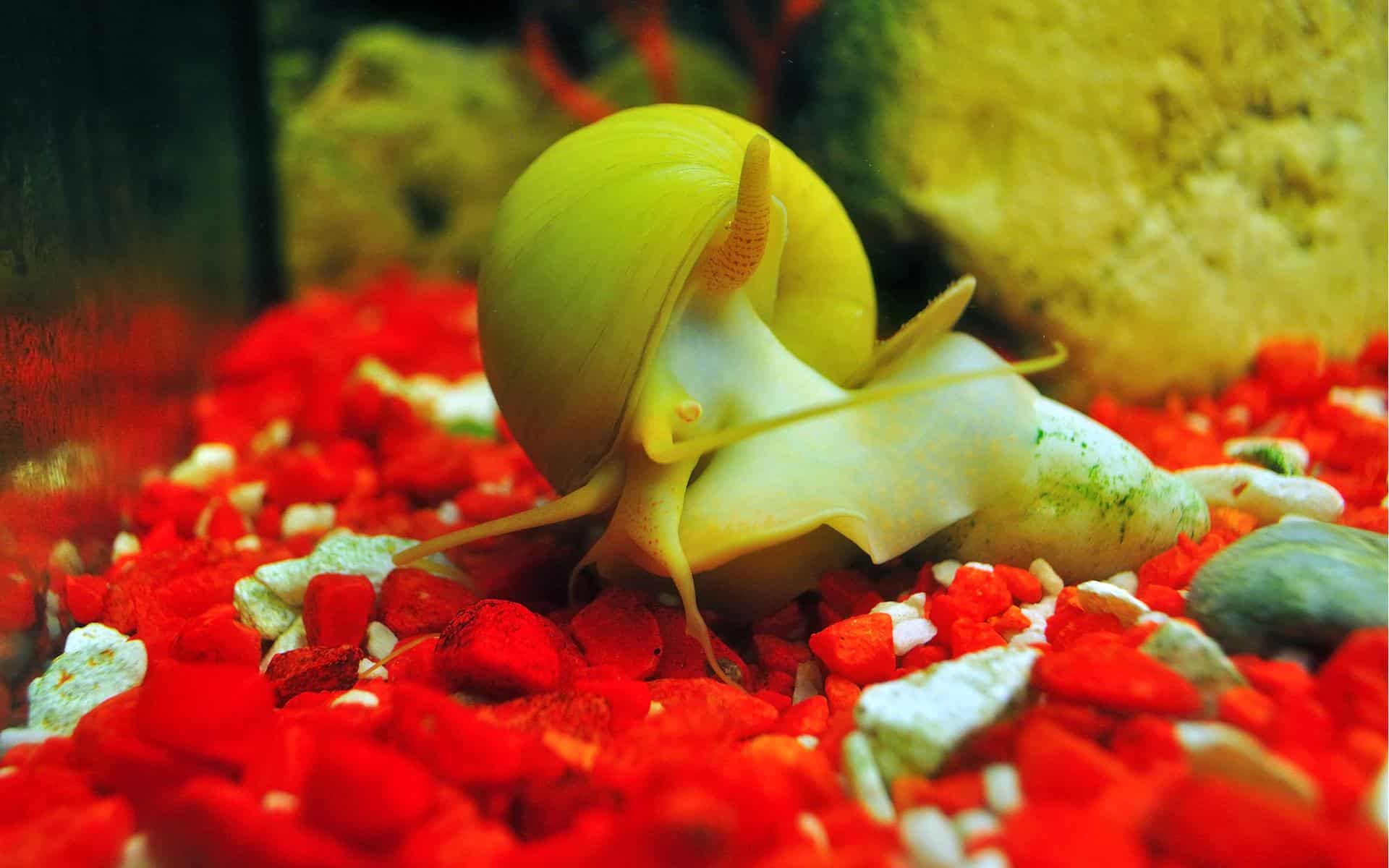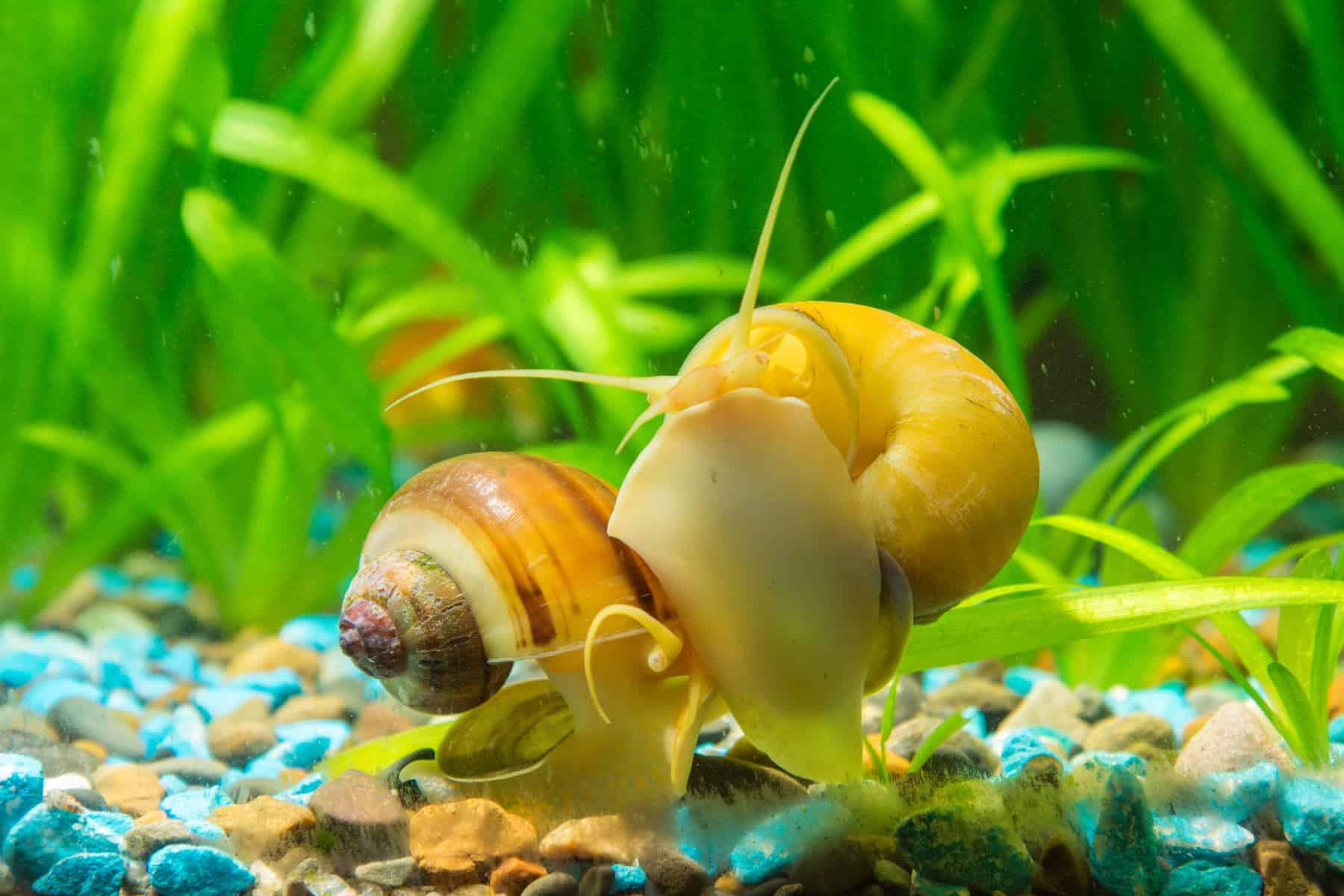The Gold Inca snail is also known as the Mystery snail. These aquarium snails are members of the Apple snail family, of which there are thought to be in excess of 100 species. Apple snails don’t generally eat your plants, preferring to graze on your tank glass and aquarium decorations, foraging for algae. If you have a sandy substrate, Gold Inca snails like to bury themselves during the daytime, coming out at night.
Although Gold Inca snails are pretty straightforward to care for, there are a few things that you must know if you plan on adding a few of these fascinating creatures to your tank.
Read our comprehensive guide to find out all you need to know about caring for the Gold Inca snail.
Gold Inca snail – overview
The Gold Inca snail is a member of the tropical Apple snail family that’s found widely across South America. These attractive gastropods are also sold under many names, including:
- Inca snail
- Gold snail
- Mystery snail
- Apple snail
- Golden Mystery snail
- Gold Mystery snail
- Mystery Apple snail
- Spike-Topped Apple snail
You’ll sometimes see these snails referred to as Pomacea australis, although their correct scientific name is Pomacea bridgesii.
Be careful when choosing snails in your local fish store. To be sure that you’re taking home a healthy snail, never buy one that has a damaged or cracked shell, and watch out for those that are moving around or are attached to a decoration or to the glass. Lively snails are usually healthy and on the hunt for food, which is always a positive sign.
A healthy Gold Inca snail lives for between one to two years, feeding on algae and decomposing plant matter, helping to keep your tank tidy, and returning nutrients to the ecosystem for your plants.
Did you know that these snails have highly complex eyes that sit on the end of a cephalic eyestalk? As the eyestalk contains no other sensory organs, it can regenerate completely in just a few weeks if it’s damaged or even severed!
Where do Inca snails come from?
The Gold Inca snail is found in Brazil, Paraguay, Bolivia, and across South America. Unfortunately, in northern areas of North America, the Chinese species of Mystery snail is regarded as an invasive species.
In nature, the snails inhabit swamps, rivers, and rivers where the vegetation is thick, providing plenty of dead and decomposing plant matter that the snails use as a food source. The Gold Inca snail typically spends most of its time on the substrate and around the plant roots, where there’s plenty to eat.
These peaceful herbivores are right at the bottom of the food chain, and they are predated by some species of fish and birds that can break through the snail’s shell.
Gold Inca snail behavior

Mystery snails are just about the most peaceful animal you can keep in your aquarium. In fact, most of the snails’ time is spent eating algae on the surfaces within your tank.
If the snail feels threatened, it will withdraw inside its shell. So, to prevent your Gold Mystery snail from becoming stressed, you should keep them with a community of peaceful, non-aggressive fishes. The more relaxed and safe the snails feel, the more active they will be, which is good news for the cleanliness of your tank.
You may notice Mystery snails crawling up to the top of the aquarium before free-falling right back down to the substrate. These neat little critters sometimes just release part of their foot, sliding down the glass instead.
What do Gold Inca snails look like?
In general, mystery snails come in a wide variety of colors, including gold, black, brown, and ivory, making a very attractive addition to the tank. You can find shells in banded, graduated, and solid varieties, so there’s plenty to choose from. The snail’s foot and head are ivory-white, adding a beautiful contrast.
The Gold Inca snail grows to around two inches in diameter, making them perfect for small and large aquariums. The snail’s shell forms a spiral whorl with the apex to the side of the creature’s opening or aperture. An adult Golden Mystery snail has around four whorls, making these snails comparatively small.
Snails have an operculum. The operculum is a thick, fleshy plate that the snails use to seal the opening of their shell. In healthy snails, the operculum will be closed. When the snail dies, the operculum falls off, and in sick snails, the operculum will hang partially open.
The Golden Mystery snail’s head has two long tentacles that the animal uses to find food and navigate around its environment. Immediately behind the tentacles are the snail’s eyes that can detect light and movement.
These senses enable the snail to find food and warn it of the presence of predators. When threatened, the snail hides inside its shell, sealing the opening by pulling up the operculum, much like a drawbridge.
Under the tentacles, the Gold Mystery snail has a second set of tentacles and its mouth, both of which are used for eating. On the left side of the snail’s head is a siphon that the snail uses to draw water through its gills.
Gold Inca snail care guide
In this section of our guide to the Gold Inca snail, we tell you how to look after these pretty little mollusks.
What size tank?
The Golden Mystery snail does fine in pretty much any size of a tank. However, as these snails are such peaceful creatures, we suggest that you add them to an established community in a 5-gallon or 10-gallon tank or larger.
The shape of the tank is immaterial; however, you must pick one with a cover slide or a tightly fitting lid to keep the snails in the tank, as they do have a habit of wandering.
How many Mystery snails can you keep?
Although the Gold Inca snail is peaceful, they still need plenty of personal space to enable them to move around and forage as they please.
So, we recommend that you keep one or two Mystery snails per five gallons.
Tank decoration and setup
The Gold Inca Mystery snail needs a tank that’s packed with thick vegetation and lots of live plants, partly as a food source and also for shelter. Plants to include in your setup are Hornwort, Java Fern, and Java Moss, all of which are easy-care, sturdy plants that are ideal for a beginner.
When it comes to tank decorations and substrate, the Gold Inca snail is not fussy and has no preferences. However, they do like to bury themselves in the substrate, so something soft and sandy is the best choice.
Water parameters
The Mystery snail is a hardy species, although they don’t appreciate rapid changes in water conditions, preferring well-oxygenated water with moderate movement. If your tank is heavily planted, the water’s oxygen levels should be fairly high, which suits the snails perfectly.
When it comes to water parameters, the snails are pretty flexible. The pH range should be between 7.6 and 8.4, with a water hardness between 12 and 18 dGH, and a water temperature of 68° Fahrenheit to 84° Fahrenheit.
The main point to note here is that snails of all species need a fairly high pH level. If the pH level falls too low, the calcium carbonate that gives strength to the snails’ shells begins to dissolve.
Once that happens, the snail is left vulnerable to harm from other tank residents. So, it’s a good idea to add calcium supplements to your tank to help keep the snails’ shells healthy and strong.
Tankmates

The Gold Inca snail doesn’t interact with the fish or invertebrates in the tank. So, basically, any peaceful fish species are fine with Mystery snails. Shrimp species also make good tankmates for snails. Other snail species can do well with the Gold Inca snail, including Nerite snails, Ivory snails, and Ramshorn snails.
Do not keep snails with Cichlids, Crayfish, Oscars, or any other fish or crustacean species that could make a meal of the snails.
Although snails are quite happy to live in isolation, Mystery snails can be kept in groups without problems, including with other snail species, provided that they are given plenty of space to grow and move around. Just be wary of overcrowding your tank.
So, allow one or two snails per five gallons of water, and you won’t go too far wrong. Overcrowding is a big issue for snails as if you have too many, and they can suffer from damaged shells, retarded growth, and a shortage of food.
Gold Inca snail diet and nutrition
Gold Inca snails are herbivores, spending much of their time grazing on the algae that grow on the surfaces and decorations within your tank.
The snails also eat decomposing and dead plant matter, only very occasionally nibbling on live plants if no other food is available. The best way to keep your snails well-fed and nutritionally satisfied is to provide them with a ready supply of natural food.
So, leave some algae growing in your tank, and add plenty of lush planting too. As plants grow, they naturally drop their leaves, providing the Gold Inca snail with an ideal food source, in addition to naturally growing algae.
The Gold Inca snail’s algae-eating habit is one reason that it’s such a popular addition to the home aquarium. These industrious little creatures will suck onto the tank sides to graze on any algae growing there, helping to keep your tank clean and tidy and saving you work in the process.
Check out the glass for signs of little tracks where the snails have grazed. Those marks are caused by a radula that they use to scrape the surface to remove the algae. Although the snails will manage just fine on what they can find in the tank, it’s a good idea to supplement that with pellets, flakes, and algae wafers.
Also, the snails will appreciate the addition of some blanched veggies, such as zucchini and lettuce. However, you must remove any uneaten items from the tank so as not to pollute the water.
Gold Inca snail health and disease
Gold Inca snails are pretty robust and healthy creatures, although they can suffer from one or two health conditions that you should know about.
Shell health
The most important thing about caring for snails is keeping their shells healthy and undamaged. Ensuring that the water pH is kept within acceptable parameters and adding calcium supplements can prevent problems with shell damage.
In the event that a snail’s shell becomes damaged, it is possible to carry out some form of repair, but you need to remove the snail from the tank and apply a fish-safe epoxy resin to the damaged area by hand, which is risky to say the least.
Rat lungworm
Angiostrongylus cantonensis is a relatively common parasite that attacks snails. The common name for the parasite is Rat Lungworm, and unsurprisingly, the adult form of the worm is found in mice and rats. However, the larvae spend part of their lifecycle maturing inside snails.
Most incidences of Rat lungworm are seen in wild snails, as the majority of those for sale in the trade are captive-bred. So, be sure to check that your snails are not wild-caught before you bring them home.
Grub worms
Grub worms are a type of fluke that have been reported in fish tanks where wild snails were kept. These parasites manifest themselves as tiny white cysts on the snail’s foot, eventually rupturing and releasing the flukes into the water column.
That’s bad news for your tank, as the flukes will attack your fish, fixing themselves to the host fishes’ body or gills or burrowing inside the fish where the parasite remains until the fish dies. Thankfully, Grub worms don’t reproduce inside your aquarium and they can be treated with an over-the-counter drug that you can buy in good fish stores.
Breeding and reproduction

Unlike some snail species that can reproduce alone, Gold Inca snails need one snail of each sex to reproduce. So, if you buy a group of snails, you’re pretty much certain to have at least one male and one female.
Breeding Mystery snails is straightforward. You don’t need a separate breeding tank, and there’s no need to change the conditions within the tank, although you can often encourage spawning by lowering the water level in the tank by an inch or so. The female snail will lay her eggs at or above the surface of the water in a cocoon.
After a month or so, the eggs will hatch, and the baby snails will tumble down to the bottom of the tank. Juvenile snails eat the same diet as their parents, so you don’t need to worry about providing them with special food.
Availability
Gold Inca snails are readily available in most fish stores. For that reason, these snails aren’t expensive to buy, costing just a couple of dollars per snail. If you buy a small group of specimens, you’ll most likely get them at a slightly discounted price.
In summary
The Gold Inca snail is a delightful little gastropod that makes a helpful and decorative addition to a peaceful community aquarium that doesn’t contain any aggressive fish species. These charming snails are entirely herbivorous, grazing on algae on the tank glass and decorations and eating decaying plant matter at the bottom of the aquarium.
Although these snails do require a reasonably high water pH or calcium supplement to keep their shells healthy, their water preferences fall well within the range of most species of easy-care tropical fish, making these beautiful, helpful creatures a nice addition to a beginner’s tank.


























